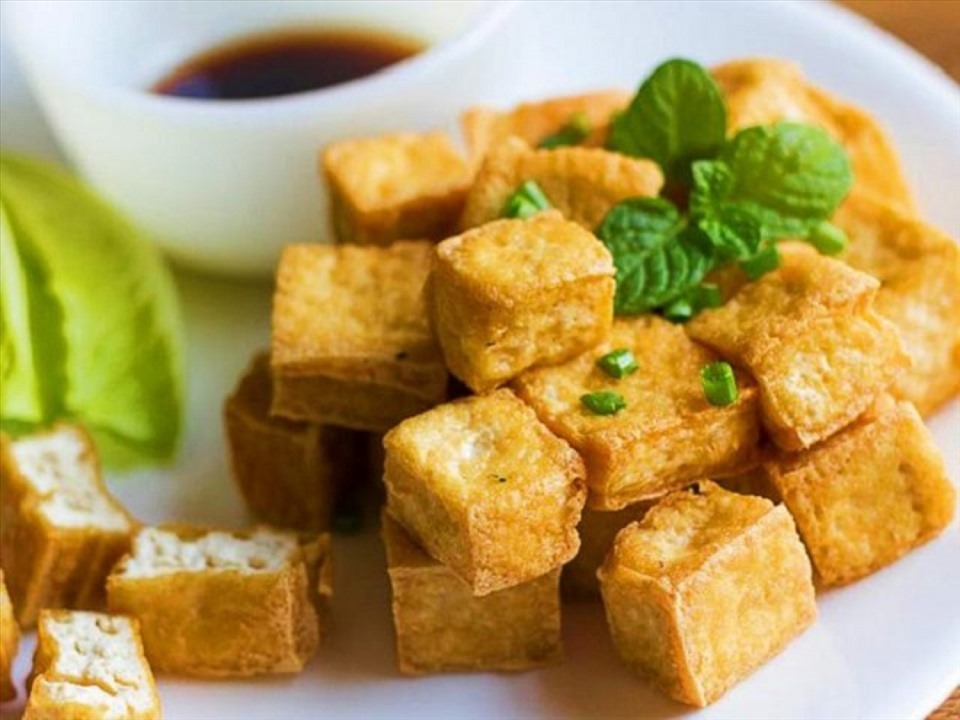Đậu phụ rán (Fried Tofu)

Nguyên liệu
Main Ingredient
-
Firm tofu (cut into slices or cubes)
Cooking Oil
-
A small amount of vegetable oil (for pan-frying or deep-frying)
Thành phần dinh dưỡng
For: Vegetarians and Vegans
Calories per serving: ~ 100–150 kcal (per 2–3 pieces, depending on size and oil absorbed)
Key Nutrients
1. Plant-Based Protein (6–8g)
- Source: Tofu
- Benefits: Supports muscle maintenance, hormone regulation, and is a complete protein containing all essential amino acids.
2. Healthy Fats (4–6g)
- Source: Cooking oil (used for frying)
- Benefits: Provides energy, helps absorb fat-soluble vitamins, and adds crisp texture.
3. Calcium (100–150mg)
- Source: Tofu (especially if made with calcium sulfate)
- Benefits: Strengthens bones and teeth, supports nerve and muscle function.
4. Iron & Magnesium
- Source: Tofu
- Benefits: Iron aids oxygen transport in blood; magnesium supports muscle function and energy production.
1. Choosing the Right Tofu
- Start with fresh, good-quality tofu. Look for tofu that has a slightly off-white color and a subtle, nutty aroma—these are signs it’s made from pure soybeans. When held, it should feel firm but not overly hard.
- Rinse the tofu gently in diluted saltwater. Pat it dry with a clean cloth or muslin. Then cut it into evenly sized squares or rectangles—small enough to handle but not so small that they break during frying.

2. First Fry – Gentle Searing
- Heat a generous amount of cooking oil or lard in a skillet. Test the oil by dipping in a chopstick—if small bubbles appear, it’s ready.
- Gently place the tofu into the hot oil and fry over medium heat. Do not stir or move the tofu immediately; let it sit to form a thin golden crust on the surface. If using a small amount of oil, you can shake the pan slightly to check if the tofu releases from the bottom—this means one side is done. Flip and cook the other side until about 70% golden and firm.
- At restaurants, chefs often use deep pans and slotted ladles to quickly fry tofu in large batches. Once the tofu is lightly crisped on the outside, remove it from the oil.

3. Shock Cooling
- Immediately rinse the fried tofu under cold water or plunge it into a bowl of ice water. This is known as thermal shock in cooking—causing the outer layer to tighten quickly, locking in moisture and enhancing natural sweetness and tenderness inside.
- Drain the tofu thoroughly or pat dry with a clean cloth. This step is widely used in Vietnamese kitchens to improve texture in stir-fried vegetables, boiled pork, organ meats, and even hard-boiled eggs.

4. Second Fry – High Heat for Maximum Crunch
- The double-fry technique has long been used in cooking to lock in flavor and texture. Whether it’s for extra crispy fried foods, well-seasoned stews, or fragrant sticky rice, two levels of heat always make a difference.
- For the second fry, use a deep pan with enough oil to fully submerge the tofu. Heat the oil until it reaches high heat—you can tell by the larger, fast-forming bubbles around a chopstick.
- Carefully add the tofu and fry quickly over high heat until the surface becomes golden and bubbly, forming a crispy shell. Stir gently to brown all sides evenly. Once the outer texture turns light and airy—resembling rice puffs—remove and place on a plate lined with paper towels.
🔸 Tip: To prevent oil splatter, make sure the tofu is thoroughly dried or lightly dusted with flour before frying.
5. Final Result
The finished tofu should be golden and ultra-crispy on the outside, with a tender, juicy interior. Even after sitting for an hour, it remains crunchy—perfect for serving with fragrant herbs like Vietnamese balm (rau kinh giới) and fermented shrimp paste (mắm tôm). For a more indulgent version, drizzle with scallion oil or toss with sweet soy sauce.

Crispy Fried Tofu: The Humble Hero of the Vietnamese Table
Fried tofu may not look like much—a few golden cubes sizzling quietly in oil—but for many Vietnamese families, it’s the taste of home, of resilience, and of everyday love.
In times when meat was scarce or out of reach, tofu stood in as the quiet provider. It was cheap, filling, and adaptable—absorbing flavors like a sponge and turning simple seasonings into something rich and satisfying. A plate of crispy tofu, served with a bowl of rice, a bit of herbs, and a dip of fermented shrimp paste or soy sauce, could feed a family with warmth and joy.
But frying tofu well takes patience. First one fry to set the shape, then a cold-water shock to lock in moisture, and a final fry for that perfect, shattering crunch. It’s a technique passed from mothers to daughters, stall vendors to apprentices, showing that even the humblest ingredients deserve care and skill.
Today, as people return to plant-based meals and crave authentic flavors, fried tofu is having a quiet renaissance. But to many of us, it never left—it’s always been there, golden and glowing, on the family table.